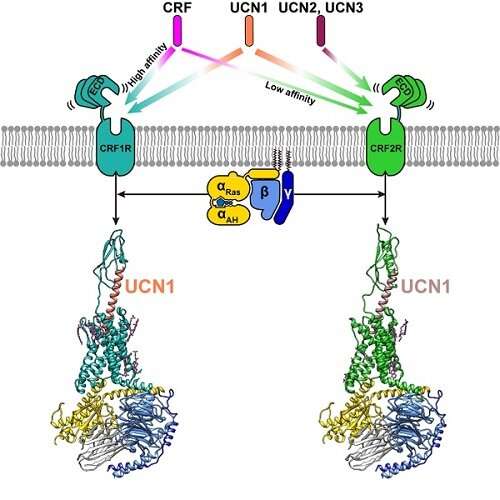Research: Structural and functional studies of corticotropin-releasing factor receptors

CRF1R and CRF2R, two members of class B G-protein-coupled receptors (GPCRs), are widely expressed in the central and peripheral nervous systems and activated by the corticoliberin family of peptide hormones that include CRF and urocortins 1-3 (UCN1-UCN3). The active receptors function as a key mediator of endocrine, autonomic, behavioral, and immune responses to stress by coupling to G protein (Gs).
CRF was first discovered in ovine hypothalamus and plays an indispensable role in the hypothalamic-pituitary-adrenal (HPA) axis by promoting the release of adrenocorticotropic hormone (ACTH) to regulate homeostasis and stress responses. CRF has a higher affinity for CRF1R than CRF2R, while UCN1 has strong and comparable affinities for both receptors and UCN2 and UCN3 are selective for CRF2R.
In a study published online in Molecular Cell, H. Eric Xu's group at the Shanghai Institute of Materia Medica (SIMM) of the Chinese Academy of Sciences, collaborating with Zhang Yan's group at Zhejiang University, revealed two cryo-electron microscopy (cryo-EM) structures of corticotropin-releasing factor receptors CRF1R and CRF2R bound to UCN1 and the stimulatory Gs, providing a template for rational design of novel therapeutics against anxiety, depression, substance abuse, and cardiovascular diseases.
These three-dimensional structures revealed the mechanism of the peptide-binding specificity and provide the structural basis for recruiting the downstream Gs protein. UCN1 has a unique structural feature compared to other class B GPCRs peptide ligands, and the first seven residues of UCN1 adopt an extended loop conformation, and its C-terminal residues (8-40) adopt a single extended helix.
In the same issue of Molecular Cell, H. Eric Xu and Zhang Yan, collaborating with Patrick M. Sexton and Denise Wootten from Monash University, also reported the cryo-EM structure of the CRF-CRF1R-Gs complex. By analyzing the electrostatic properties of the three structures, they found that the CRF surface is more negatively charged, which fits the CRF1R pocket better, consistent with the fact that CRF has a higher potency to CRF1R than to CRF2R.
Class B GPCRs are involved in a very distinct set of physiological activities that require exquisite specificity of ligand binding and receptor activation. In this study, the researchers provided systematic analysis of the precise peptide-binding mechanism in class B GPCRs by comparing the previously reported active class B GPCR structures.
In particular, collaborating with other laboratories, the researchers revealed the cryo-EM structure of PTH1R in complex with Gs. Structural comparison among the structures showed that the extra-cellular domains (ECDs) bound to the C-terminal portions of the peptide ligands display the most pronounced conformational differences. Although the secondary structures and scaffold of the transmembrane domains (TMDs) bound to the N-terminal portions of the peptide ligands are quite similar, the sizes and shapes of the peptide-binding pockets are divergent for each receptor.
In addition, according to structure-based sequence alignment, the peptide ligands of class B GPCR family can be divided into three subgroups. Therefore, the exquisite specificity of peptide hormone recognition by class B GPCRs is controlled at two levels. The first step is the fast recognition by the receptor ECD and then the N-terminal portions of the peptide ligands penetrate into the receptor TMD which is a key step to determine the specificity of the peptide ligands. The two-step recognition pattern prevents the misfiring of the receptor by accidental interactions with unrelated peptides or proteins.
Compared with the antagonist-bound CRF1R TMD structure, the remarkable conformational changes focus on TM5, TM6 and TM7, especially the "NPGQ" motif. The Gαs α5 helix is the primary structural element to interact with the receptor TM helices and the Gβ subunit mainly interacts with the receptor helix 8. The highly conserved "NPGQ" motif and the interaction surface between class B GPCRs and Gs protein suggested a common mechanism of class B GPCR activation.
Similar with the PTH1R-Gs complex reported before, both CRF1R and CRF2R complexes unveiled annular detergent micelle surrounding the transmembrane helices of the receptors. Within the micelle, several bound cholesterol molecules are clearly visible in the cryo-EM maps and these cholesterol-binding sites overlap with each other across all three structures. Two cholesterols fitting well in the EM density map were chosen to study the membrane protein-lipid interaction.
The residues interacting with the two cholesterols are highly conserved in class B GPCRs and alanine mutations in these residues reduced the activation potency of UCN1 and CRF to CRF1R and CRF2R. Besides, the lipid-modified moieties of Gαs and Gβγ were observed. Together, the results suggest that the cholesterols play an important role in stabilizing peptide binding and GPCR signaling.
The active UCN1-CRF1R-Gs and UCN1-CRF2R-Gs complexes reveal the basis for peptide binding specificity, support a universal mechanism of class B GPCR activation, and provide detailed structural information for studying membrane protein-lipid interactions. Finally, the structures provide a rational template to understand the structure-activity relationship of drug-discovery ligands targeting CRF1R and CRF2R-related diseases.
More information: Shanshan Ma et al. Molecular Basis for Hormone Recognition and Activation of Corticotropin-Releasing Factor Receptors, Molecular Cell (2020). DOI: 10.1016/j.molcel.2020.01.013
Yi-Lynn Liang et al. Toward a Structural Understanding of Class B GPCR Peptide Binding and Activation, Molecular Cell (2020). DOI: 10.1016/j.molcel.2020.01.012
Journal information: Molecular Cell
Provided by Chinese Academy of Sciences

















